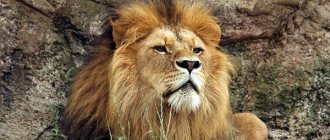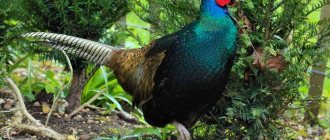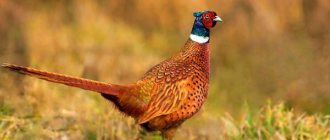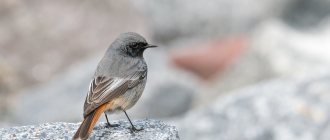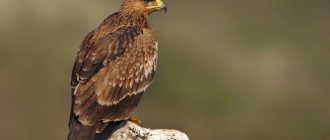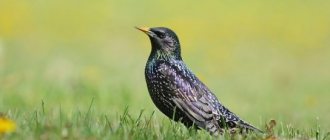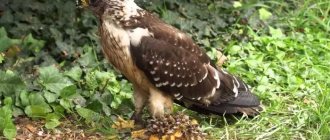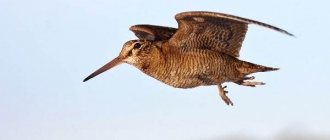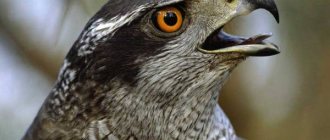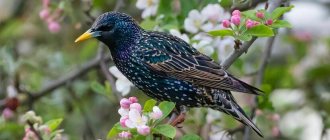- Wild animals
- >>
- Birds
The pheasant is a domesticated bird belonging to the order Galliformes. These Eurasian birds are popular in households and are often raised for hunting. The bird is very attractive in appearance and has bright plumage. Meat is considered dietary and is considered a delicacy on the world market. The pheasant in its natural environment is an extremely shy animal. He likes to live in solitude, so it is difficult to get a photo of a pheasant, because... he rarely finds himself in front of a camera lens.
Structure and appearance
In the broad sense of the word, pheasants include those galliformes that have very deep notches on the posterior edge of the sternum - notches exceeding half the length of this bone, as well as a shorter main phalanx of the hind toe than the corresponding phalanx of the third toe.
Unlike the hoacin family (lat. Opisthocomidae
;
now classified as a member of the order Cuckoo-shaped) the keel of the sternum is well developed; unlike the gokko family (lat. Cracidae
) and the bigfoot family (lat.
Megapodiidae
) - the rear toe is located higher than the front toes.
In this sense, the majority of true galliform birds with a rather short, curved and strong beak, the slit-like nostrils of which are usually covered with bare plates, belong to the pheasant group; relatively small head and strong neck; often with bare, unfeathered areas on the head, especially around the eyes, and sometimes with fleshy growths on the chin, near the ears or on the forehead and crown of the head; short rounded wings; with strong and rough legs, adapted for walking and for breaking the ground.
Of the number of characters characterizing this subfamily, spurs, which almost always exist on the legs of males, deserve attention, then short, strongly rounded wings, usually long and wide, a roof-shaped tail of 12-18 feathers, of which the middle ones are often elongated, and finally, widened in the shape of a horizontal plate corresponding to the strong development of the tail feathers is the spinous process of the last caudal vertebra.
The differences between males and females are especially pronounced here. Males are generally distinguished by brilliant, often very bright plumage.
People and pheasants[ | ]
Representatives of three genera of the subfamily, Gallus
,
Pavo
And
Phasianus
, domesticated by humans. Domestic chicken (
Gallus gallus
) is the main and most numerous species of poultry.
The most famous birds of this subfamily also include the common pheasant ( Phasianus colchicus
), widely distributed throughout the world as a subject of hunting in the form of introduced feral populations and through breeding on specialized farms.
Many other pheasant species, such as the golden pheasant ( Chrysolophus pictus
), are readily used for aviary keeping. Of the pheasants most often brought to Europe, the mottled Chinese pheasant (Syrmaticus reevesii), the diamond pheasant (
Chrysolophus amherstiae
) and one of the common subspecies - ring-necked pheasant (
P.c. torquatus
).
Pheasant hunting[ | ]
Due to their beautiful plumage and tasty meat, pheasants have been valuable hunting objects since ancient times.
In steppe areas, the most productive hunting occurs in the spring, during high water, when pheasants, pressed by water, gather in fairly large flocks on elevated places, to which hunters approach in boats. In the same areas, during winters with little snow, reed-covered plains are cordoned off, where pheasants feed on snowy vegetation, look out for hidden birds (by a trickle of steam from their breath) and shoot at them almost point-blank, or even simply kill them with sticks. There, as well as in the Caucasus, pheasants are hunted with dogs: pointers, hounds and even mongrels; these latter, having driven the brood from the ground, continue to bark at the pheasants scattered in the trees, and thereby distract their attention from the hunter approaching them to shoot.
In forests where pheasants spend the night in trees, hunters look for them at dusk and, aiming at the silhouette drawn against the sky, hit them almost without missing. The best time for hunting is October and November, when the broods of pheasants have not yet broken up. The best hours of the day are in the morning before 10 o’clock and in the evening after 4 o’clock, when pheasants come out of the thicket onto the lawns, forest edges or reeds and fatten; the rest of the time they lie in inconspicuous places, leaving no trace, which makes the dog’s work more difficult.
Pheasant fishing. Facsimile of a reproduction from the manuscript
"Livre du Roy Modus"
(XIV century)
Pheasants do not easily rise in front of a dog and prefer to flee, confusing the trail in circles and generally winding their way. When taking off, pheasants, especially males, make such a noise with their wings that inexperienced hunters, stunned by it, often miss. Hunters sometimes approach fattening pheasants for a shot, hiding behind the filly
- a portable canvas shield with a small hole in the middle through which a gun is inserted.
In the past, pheasants were mostly exterminated by all kinds of snares and traps. Snares were sometimes placed in the collars of a large cap woven from twigs, in the middle of which grape marc or other food was poured for bait.[3]
Pheasants tolerate frosts well (and bury themselves in the snow at night), as a result of which they began to be bred outside their geographical distribution: caring for such acclimatized birds is simple and is expressed mainly in feeding them in winter and intensified extermination of feathered and four-legged predators. Previously, in some well-maintained hunting grounds, however, such pheasants were caught for the winter, which they spent in barns, and released again in the spring. Later, entire specialized farms for breeding pheasants began to be established.
Most often pheasants are bred in this way: common ( P. colchicus
), silver (or silver lofura;
Lophura nycthemera
), golden (
Chrysolophus pictus
), green (or Japanese;
P. versicolor
). Bred pheasants are usually hunted either with a pointing dog or in round-ups[4].
Where does the pheasant live?
Photo: Pheasant in nature
The pheasant is a non-migratory species living in Eurasia. The natural distribution zone of the pheasant passes through the south of the Central and Eastern Palearctic, as well as parts of the eastern region. The range extends from the Black Sea in a wide belt south of the forest and steppe zone east to western Chinese Qinghai and the southern edge of the Gobi region, including Korea, Japan and the former Burma. It is present in Europe, North America, New Zealand, Australia and Hawaii. In North America, pheasant populations range across mid-latitude agricultural lands from southern Canada to Utah, California, and south into Virginia.
Interesting fact: The settlement areas are very fragmented, part of the population consists of separate subspecies isolated from each other. On the other hand, east of extreme southeastern Siberia and northeastern China, a large closed area extends south through most of China, as well as Korea and Taiwan north of Vietnam, Laos, Thailand and Myanmar, where transitions between subspecies are less noticeable .
Additionally, the species has been naturalized in many parts of the world with varying degrees of success. Today it lives throughout most of Europe. These birds are rare only in Greece, the Italian Alps and parts of southern France. In the Iberian Peninsula and northern Scandinavia it is almost completely absent. In places there are in Chile.
Pheasants occupy meadows and agricultural land. These birds are generalists and occupy a wide range of habitat types, excluding areas with dense tropical forests, alpine forests or very dry areas. This flexibility allows them to explore new habitats. Open water is not essential for pheasants, but most populations are found where water is present. In drier areas, birds obtain water from dew, insects and succulent vegetation.
Now you know where the bird of the pheasant family lives. Let's see what she eats.
Interspecific hybridization
Phasianidae
capable of mating between different species and even genera and the formation of hybrids.
Some of the hybrids, such as hybrids from males of the common pheasant (lat. Phasianus colchicus
) and female Japanese pheasant (
P. versicolor
) or hybrids within the genus
Gallus
, are fertile, meaning they can reproduce.
In poultry houses, hybrids between domestic roosters and the genera Phasianus
and
Lophura
.
Genetics[ | ]
Molecular genetics
- EntrezNucleotide
database , GenBank, NCBI, USA: 899,746 (accessed February 3, 2015). - EntrezProtein
database , GenBank, NCBI, USA: 55,417 (accessed February 3, 2015).
Most of the deposited sequences belong to the chicken ( Gallus gallus
) is the genetically most studied representative of the pheasant subfamily and the class of birds as a whole. The chicken was the first bird and the first domestic animal to have its genetic and physical maps mapped and its entire genome sequence sequenced (in 2004)[6][7][8][9]. The priority in constructing the first genetic map of chicken and its publication in 1930[10][11] belongs to the Soviet Russian scientists A.S. Serebrovsky[12] and S.G. Petrov[13].
What does a pheasant eat?
Photo: Pheasant
Pheasants are omnivorous birds, and therefore pheasants feed on both plant and animal matter. But the largest proportion of the diet consists of only a plant diet, with the exception of the first four weeks of life, when the chicks mainly eat insects. Then the share of animal food decreases sharply. Plant food consists of seeds, as well as underground parts of plants. The spectrum ranges from tiny seeds of small clove plants to nuts or acorns.
Birds can eat hard-shelled fruits and berries that are poisonous to humans. In late winter and spring, shoots and fresh leaves become a priority in the diet. increasingly collected. The range of food varies depending on the area. Small insects and their larvae often accumulate in surprising numbers. For digestion, 1-5 mm pebbles are taken or, if this fails, parts of snail shells or small bones. During breeding, females are more likely to ingest limestone pebbles.
The search for food occurs mainly on the ground. Birds sometimes break through fresh snow up to 30-35 cm deep. Often food is collected in the form of tiny components, pieces of larger products.
The main diet of pheasants consists of:
- seeds;
- berries;
- shoots;
- grains;
- fruit;
- insects;
- worms;
- caterpillars;
- snails;
- grasshoppers;
- larvae;
- crickets;
- sometimes small reptiles;
- lizards
Pheasants forage early in the morning and in the evening. Important crops that birds eat include corn, wheat, barley and flax.
